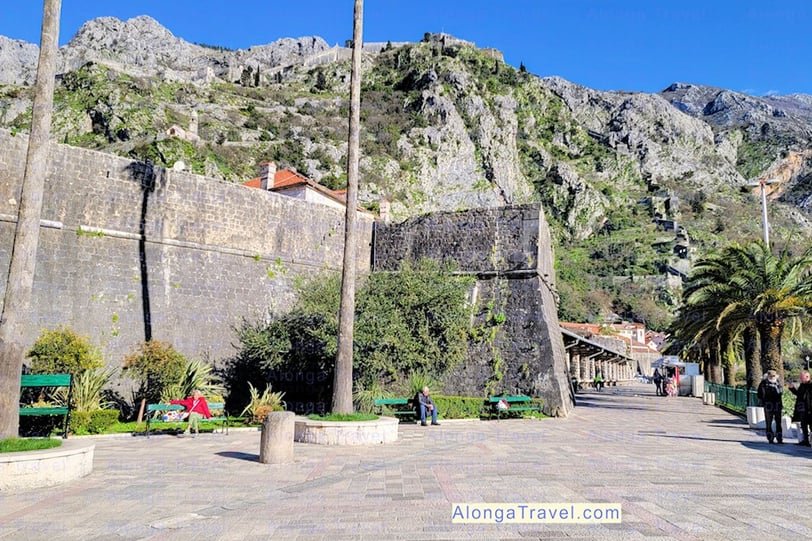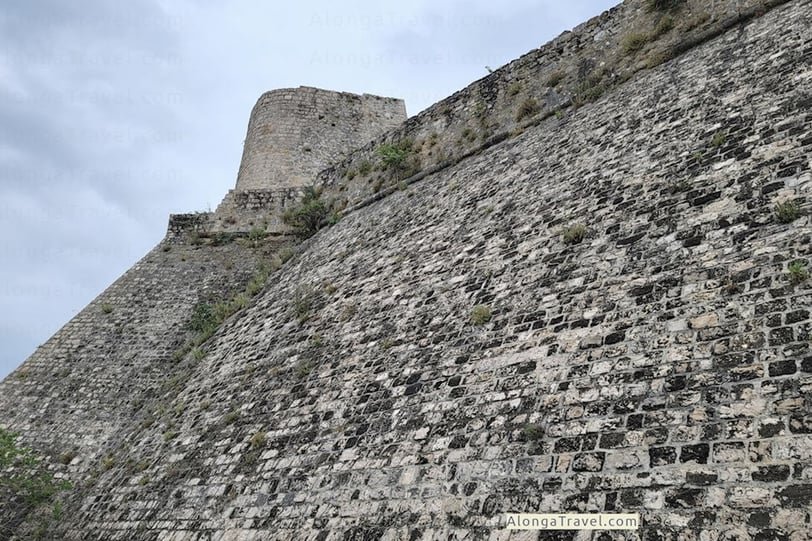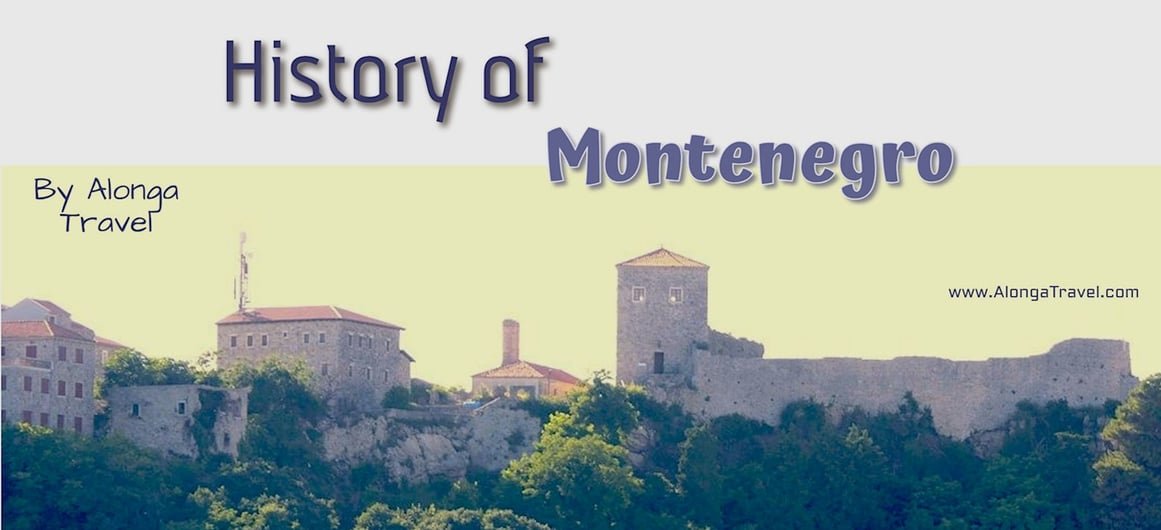History of Montenegro thru Kotor, Risan and Ulcinj unique histories.
Montenegro, a small country in southeastern Europe, has a rich and diverse history that spans back to ancient times.
Not only that, but different cities of the modern-day Montenegro have their own unique history, as they were influenced and conquered by different empires throughout the years.
In this post, I will explore the general history of Montenegro and also focus on its three most significant historic towns: Kotor, Risan, and Ulcinj.
First, the general history of Montenegro.
HISTORY OF MONTENERGO
The region was inhabited by the Illyrians before the Roman Republic incorporated it into the province of Illyricum.
In the Early Middle Ages, Slavic migration led to the formation of several Slavic states. In the 9th century, there were three main territories in Montenegro: Duklja in the south, Travunia in the west, and Rascia in the north.
In 1042, Stefan Vojislav led a rebellion that resulted in Duklja gaining its independence and the establishment of the Vojislavljević dynasty. The power and influence of Duklja peaked under Vojislav’s son, Mihailo, and grandson, Bodin.
However, by the 13th century, the region was commonly referred to as Zeta instead of Duklja.
In the late 14th century, the southern part of Montenegro (Zeta) came under the control of the Balšić noble family, followed by the Crnojević noble family.
By the 15th century, Zeta was often called Crna Gora, meaning black mountain in Venetian.
During this time, various parts of Montenegro fell under the rule of the Ottoman Empire from 1496 to 1878, including cities such as Podgorica and Ulcinj.
However, even during the Ottoman rule, some areas of Montenegro were also controlled by the Republic of Venice, like Kotor and Herceg Novi.
From 1516 to 1852, the rulers were the prince-bishops (vladikas) of Cetinje. The House of Petrović-Njegoš then ruled until 1918, when Montenegro became a part of Yugoslavia.
Montenegro declared independence on June 3, 2006, following an independence referendum held on May 21 of the same year.
Read about these facts and more on history of Montenegro from these sources:
2. Balkan babel : the disintegration of Yugoslavia from the death of Tito to the fall of Milošević.
Let’s talk here about the history of its 3 most important historic towns – Kotor, Risan and Ulcinj. They all have their own separate histories, so it’s important to talk about them.
HISTORY OF KOTOR, MONTENEGRO
Kotor, a town in Montenegro, has a long and complex history. Learning the major events of its history is important to understand the Kotor’s town fortifications, churches and building and Venetian architecture.
As I mentioned before, some part of its history is unique to just this town, and different from the rest of Montenegro. But other parts are similar.
THE ANCIENT TIMES
The town of Kotor was started by the Illyrians.
How old is Kotor old town? Historians think it might have been around 2000 years ago. The town was mentioned for the first time in 168 BC. Back then, it was called different names like Acruvium and similar names, and it was part of Byzantine Dalmatia, which was controlled by Ancient Rome.
In 535, Emperor Justinian built a fortress above Acruvium, fortifying the town. However, in 840 it was attacked by the Saracens and suffered damage.
The town was fortified even more extensively in the 10th century by Constantine VII.
THE MEDIEVAL TIMES
Kotor was an important city in Dalmatia and the Dalmatian language was spoken there.
In early 11th century, Kotor was conquered by the Bulgarian Empire and was given to Deoclia. Despite this, the people of Kotor did not want to give up their autonomy and with the help of Dubrovnik, they were able to maintain it. However, Byzantium regained control in 1143 and Kotor lost its autonomy.
Stefan Nemanja, the leader of Serbia, took over the city in the late 12th century. Stepan Nemanja was the founder of the Nemanjić dynasty.
In the 13th century, Kotor was an Episcopal religious center under the authority of the archbishopric of Bari. Two monasteries were established by the Dominicans and Franciscans to stop the expansion of Bogomilism around that time. Read more in my other post about Dominicans and Franciscans monasteries of Kotor old town.
During the Nemanjić reign, Kotor enjoyed partial autonomy as a city and maintained its republican institutions, with numerous privileges.
Kotor was very important for trade for the Serbian Empire. By the 14th century, Kotor’s commerce rivaled that of the Republic of Ragusa, making the Republic of Venice envious. Even after the downfall of the subsequent Serbian Empire, Kotor continued to serve as the most important trading port.
Kotor changed hands frequently between Hungary and Venice from 1371-1384. After that, Bosnia’s Tvrtko I Kotromanić held Kotor from 1384-1391 and minted coins there. Kotor became independent after Tvrtko’s death, but later sought protection from Venice in 1420 due to Ottoman threats in the region.
Kotor during THE VENETIAN TIMES
From 1420 to 1797, Kotor was a part of the Venetian Republic’s Venetian Albania province.
In the 14th and 15th centuries, Kotor saw an influx of migrants from the surrounding territories of Trebinje and Hum, which led to a growth in its population. The city was called Cattaro by Italians back then.
Venetian military architects rebuilt and renovated the existing Kotor Fortifications.
THE MISFORTUNE TIMES of Kotor, Montenegro
While under Venetian control, Kotor suffered under Ottoman Empire sieges in 1538 and 1657, the plague in 1572, and earthquakes in 1563 and 1667 that almost destroyed the city.
HABSBURG MONARCHY, FRENCH, RUSSIANS AND BRITISH and Kotor
In 1797, Kotor was given to the Habsburg monarchy. But in 1805, another Treaty assigned it to the Napoleonic Kingdom of Italy, though it was held by the Russians. Sounds complicated, isn’t it?:)
Eventually, the Russians have left and Kotor joined the Kingdom of Italy in 1806 and the Illyrian Provinces in 1810. Finally, Kotor could time some break, right? Wrong!:)
The British captured Kotor in 1814 after a serious of complicated attacks with the use of ships with many cannons.
The French had no choice but to surrender.
Kotor was then restored to the Habsburg monarchy by the Congress of Vienna.
So, Kotor was ruled by 4 different countries during the span of 21 years!!
Kotor during WORLD WAR I
During World War I, specifically in the early 1900s, Cattaro served as one of the main bases of the Austro-Hungarian Navy. It was home to the Austrian Fifth Fleet, which was composed battleships and light cruisers. Additionally, the area served as a base for Austrian and German submarines.
Sadly, this region also saw some of the most intense battles between local Montenegrins and Austria-Hungary.
In 1918, Cattaro became a part of Yugoslavia and was officially renamed Kotor.
Kotor during WORLD WAR II
From 1941 to 1943, the Kingdom of Italy took over Kotor and included it as one of the provinces in the Italian Governorate of Dalmatia. This province, known as the Province of Cattaro. It was home to a population of 40,000 individuals, mostly Orthodox with a few Roman Catholics.
When the war ended, the small remaining population of Dalmatian Italians in Kotor (300 inhabitants) left Yugoslavia and migrated to Italy as part of the Istrian-Dalmatian exodus.
MODERN TIMES of Kotor
The modern history of Kotor after World War II began with the city being incorporated into the Socialist Federal Republic of Yugoslavia. The city and its surrounding area became a part of the Republic of Montenegro. The capital of Montenegro was declared to be Podgorica. During this period, the city underwent several infrastructural developments, including the expansion of the city’s port and the construction of new residential areas.
However, in the late 20th century, the city encountered several challenges, including economic hardship and political instability. Kotor, like many other cities in Yugoslavia, was affected by the Balkan Wars of the 1990s. The city was under siege by Yugoslav forces during the Montenegro War in 1999, leading to significant damage to its infrastructure.
In the early 21st century, Kotor underwent a significant cultural and economic revival. The city’s historic old town has been designated a UNESCO World Heritage site, attracting a significant number of tourists to the area. The proximity of Kotor to Tivat Airport is very helpful. The airport is considered to be Kotor airport.
Another popular attraction drawing tourists is the Bay of Kotor and water activities.
Kotor has also become a popular site for cultural events, such as the Kotor Art music festival.
Kotor is located on the major bus route from Dubrovnik, Budva, Tirana, and Sarajevo and Mostar.
Today, Kotor is a thriving cultural and economic hub, with a population of around 13,000 inhabitants. The city has preserved its rich cultural heritage while also pursuing modernization and growth.
There are many fun things to do in modern Kotor, it’s also a great destination for a city break.
There are other important historic towns in Montenegro with significant history.

Risan: the oldest town in Montenegro
Risan, located in the Bay of Kotor in Montenegro, is the oldest settlement in the region, with a history dating back to the Bronze Age. People first arrived in Risan around the 6th millennium BC. It later became a Greek colony around 300 BC and served as a prominent center for Illyria’s maritime trade. The city thrived economically, with its own money forge indicating its wealth.
During the Illyrian Wars, Risan was a main fortress and a place of refuge for Queen Teuta. It was highly influenced by Greek culture and enjoyed prosperity during Roman times, with grand villas and a population of 10,000 people in the 1st and 2nd centuries.
However, Risan suffered from invasions by the Avars and Slavs, leading to its abandonment. The last mention of a Roman bishop in Risan dates back to 595. In the 10th century, it was included as an inhabited town in the region of Travunia by the Byzantine emperor Constantine Porphyrogenitus.
During the Middle Ages, Risan lost its former significance, and by the mid-15th century, it was referred to as a town of Herceg Stjepan. In 1482, the Ottomans captured Risan along with Herceg Novi from Vlatko, the son of Herceg Stjepan.
In 1688, Risan came under Venetian rule as part of Albania Veneta and was renamed Risano. During this time, it experienced a temporary economic boom. Over the subsequent centuries, Risan shared the fate of Dalmatia as a whole. It briefly became part of the Kingdom of Italy during World War II under the Italian Governatorate of Dalmatia.
Risan Modern time
Currently, Risan is part of the newly independent Montenegro.

Mosaic of Hypnos, God of sleep, is located in Risan and is a part of the Roman Mosaics of Risan. Image: Sailco, CC by 3.0
Ulcinj, an old pirate’s lair
Ulcinj, one of the oldest settlements on the Adriatic coast, was founded around the 5th century BC. The Romans took control of it in 163 BC, and later it became part of the Byzantine Empire and the Serbian Kingdom in the Middle Ages
In 1405, the Venetians conquered the town and changed its name to Dulcigno. It became a part of Albania Veneta under Venetian control.
However, in 1571, the Ottoman Turks took over Dulcigno. They were able to do this because of help from Barbary pirates. After the victory, the pirates stayed and this is when the town gained a notorious reputation as a haven for pirates, until Mehmed Pasha Bushati put an end to it.
The town was then renamed Ülgün and remained under Ottoman rule for over 300 years.
During the Ottoman rule, the town gradually became predominantly Muslim (read an account by historian Luigi Paulucci, Le bocche di Cattaro nel 1810 – Relazione di Luigi Paulucci by Luigi Paulucci.) due to several factors.
One significant factor was the influx of Muslim populations, including Albanians and Ottoman Turks, who settled in the area. These settlers brought their Islamic faith and culture with them, contributing to the growth of the Muslim population.
Additionally, the Ottoman rule implemented policies that were more favorable towards Muslims, allowing them to practice their religion more freely compared to other Christian denominations. This relatively tolerant environment attracted more Muslims to the town.
Ulcinj saw the construction of hammams, mosques, and clock towers in an oriental style.
Ulcinj remained under Ottoman rule for over 300 years until Ulcinj was ceded to the Principality of Montenegro in 1880.
Today, it remains a culturally diverse town with a significant Muslim presence. Ulcinj has several historic sites today that are well preserved.

The historic walls of Ulcinj in Montenegro. They look very impressive and are fun to explore. I found myself returning to see them every day when I was staying in Ulcinj in 2023.

One of the well preserved historical places in Ulcinj, Muzeu Kish-Xhami. It is temporary closed in 2024 due to renovation.
The history of Montenegro and its cities is fascinating and reads like an exciting book.
I hope you’ll find the information here helpful.
Let’s connect on social media!
If you would like to support my work and this website maintenance cost, that would be greatly appreciated! Thank you!
Subscribe to my periodic newsletter and never miss my latest post.

